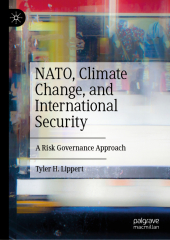 Neuerscheinungen 2019Stand: 2020-02-01 |
Schnellsuche
ISBN/Stichwort/Autor
|
Herderstraße 10
10625 Berlin
Tel.: 030 315 714 16
Fax 030 315 714 14
info@buchspektrum.de |

Tyler H. Lippert
NATO, Climate Change, and International Security
A Risk Governance Approach
1st ed. 2019. 2019. vi, 263 S. 1 SW-Abb. 210 mm
Verlag/Jahr: SPRINGER, BERLIN; SPRINGER INTERNATIONAL PUBLISHING 2019
ISBN: 3-03-014559-X (303014559X)
Neue ISBN: 978-3-03-014559-0 (9783030145590)
Preis und Lieferzeit: Bitte klicken
This book offers a prospective analysis of the anticipated security consequences of climate change in relation to the North Atlantic Treaty Organization (NATO). Using climate and security literature to complement recent foresight and scenario analysis developed by NATO, the author applies the International Risk Governance Council´s (IRGC) Risk Governance Framework to identify the considerations and actions that could assist NATO in a context where climate and environmental factors more intensively shape security. Tyler Lippert explores how climate change has the potential to increase the need for humanitarian assistance and disaster response, to create tension over shared resources, to renew and enhance geo-political interest in the Arctic, and to deepen concern with respect to the Middle East and North Africa (MENA). Within this new political and environmental reality, NATO must consider how to adapt to meet new demands, prepare for new security challenges, as well as manage unforeseen consequences.
Offering a corrective, this book identifies near-term actions for NATO to improve its risk governance posture, providing a basis upon which longer-range policy considerations can be developed. This analysis is only the opening salvo of what is likely to be a complicated process that spans many years, if not decades. However, in mapping the risk governance dimensions to the security and climate nexus from the perspective of NATO, Lippert provides a foundation for risk-based policy planning for NATO. The book will be of immense value to policy and decision makers: NATO leadership and its affiliated organizations as well as to academics across a broad span of subject areas, particularly environmental sociology, defense and foreign policy, and the political sciences.
Table of Contents I. Abstract II. Chapter 1: Introduction A. Overview B. Research Aims and Objectives C. Abbreviations D. Scope of the Analysis III. Chapter 2: Literature Review A. Introduction B. Climate Change and Security Consequences C. Critical Aspects of Climate Change D. Empirical Models of Climate Security E. Conclusions IV. Chapter 3: Taking Stock of the Situation: NATO A. Introduction B. NATO´s Big Picture-What Future? C. Historical development and transformation of NATO D. NATO, Climate, and the Environment 1. NATO and Middle East/North Africa 2. NATO and the Arctic 3. Creation of NATO´s Emerging Security Challenges Division E. NATO Foresight Efforts: The Future Security Environment 1. NATO ACT Strategic Foresight Analysis 2. NATO ACT-Framework for Future Alliance Operations 3. Instability Situations - (Hazards) a) Access and Use of Global Commons Challenged b) Disruptive Impact of Migration c) Large-Scale Disaster 4. Review and Critique of Instability Situations 5. To What Extent do the NATO ACT Instability Situations Represent NATO´s Perspective? F. Conclusions V. Chapter 4: Methodology & Context A. Introduction B. Why Risk Governance? NATO and Climate Security Risk C. The IRGC Risk Governance Framework 1. Summary of Characteristics: NATO, Climate Security, and Risk Governance 2. Previous Application of the IRGC Risk Governance Framework D. Risk Governance: Institutions & Context 1. The Institutional Structures 2. Climate Policies and Plans: NATO Militaries and Defense Ministries 3. The Context of NATO Decision Making: Consensus and the Silence Procedure 4. NATO in the context of a new environment 5. The Potential for Confoundedness E. Conclusions VI. Chapter 5: A Risk Governance Case Study A. Introduction B. Phase 1: Pre-Assessment 1. Risk (or, Problem) Framing 2. Early Warning 3. Screening 4. Scientific Conventions 5. NATO´s ability to perform pre-assessment C. Phase 2: Risk Appraisal 1. Risk Assessment a) Complexity b) Uncertainty c) Ambiguity 2. Concern Assessment 3. NATO´s ability to perform Risk Appraisal D. Phase 3: Tolerability and Acceptability Judgment 1. Risk Characterization & Evaluation: Climate and Security for NATO a) Risk Characterization b) Risk Evaluation 2. NATO´s ability to perform Tolerability and Acceptability E. Phase 4: Risk Management 1. NATO´s ability to perform Risk Management F. Risk Communication 1. NATO´s ability to perform Risk Communication G. Conclusions VII. Chapter 6: Major Findings A. Introduction B. Findings: Climate Change and International Security: NATO´s Risk Governance C. Recommendations: A Basis for Prospective Risk Management Options D. Discussion: Assessment of the IRGC Framework E. Closing Remarks VIII. Bibliography


